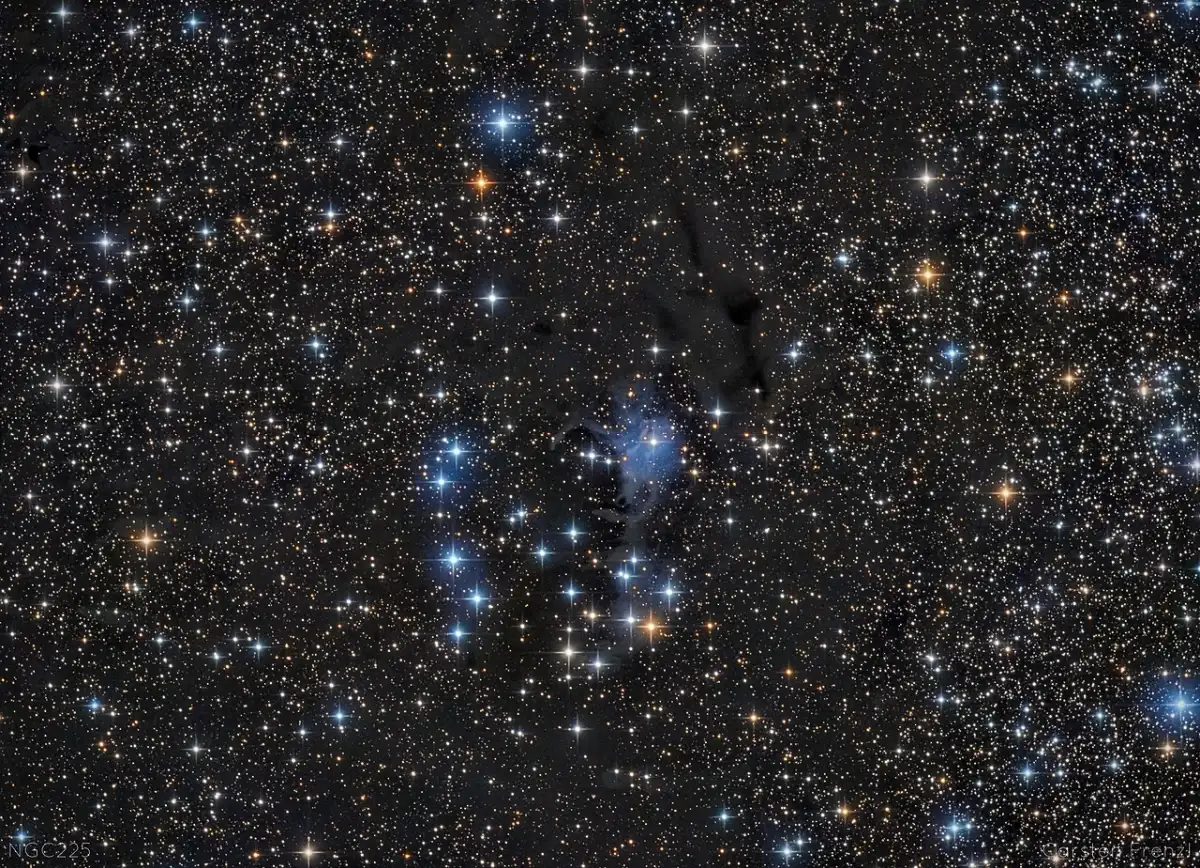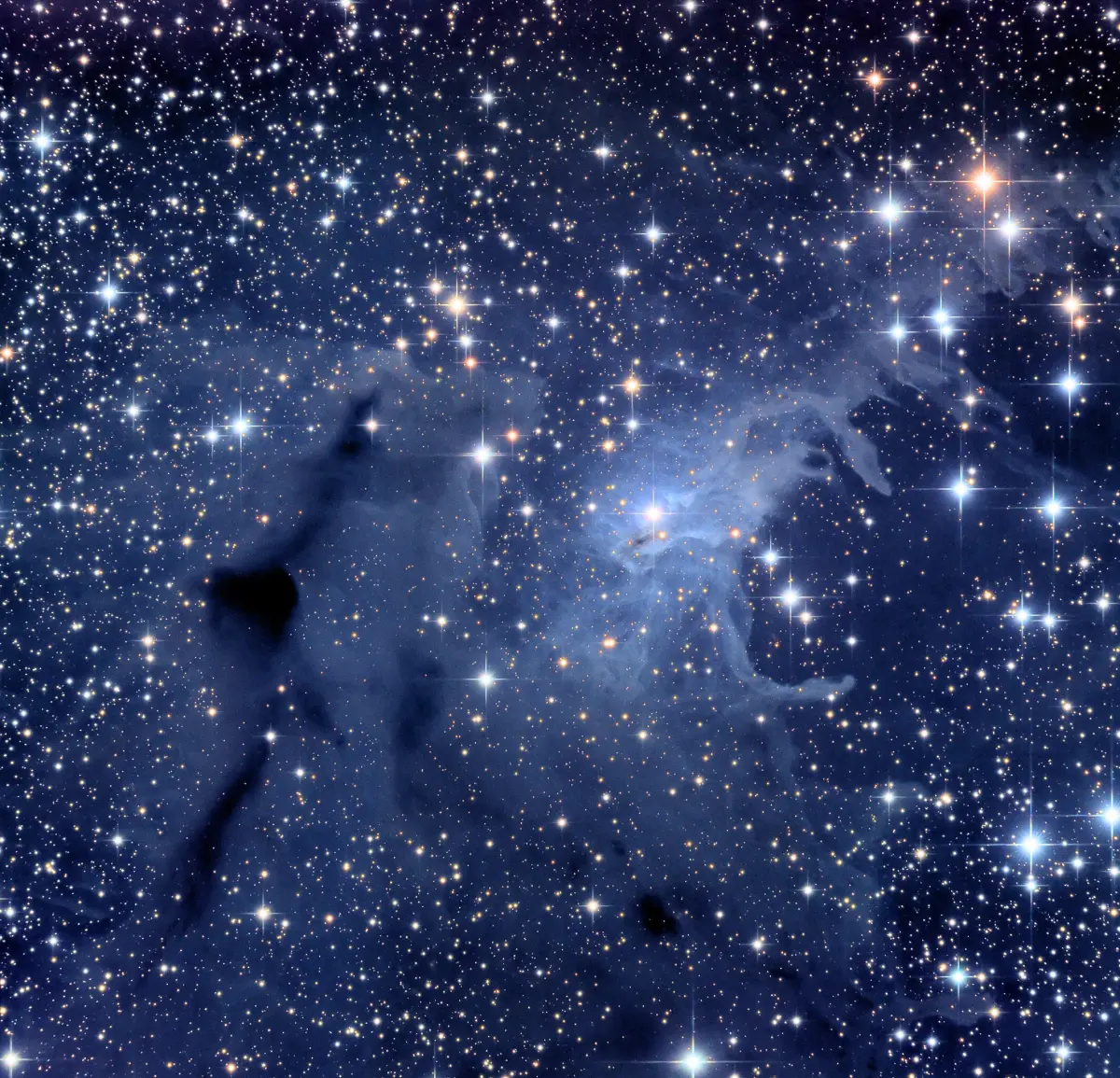The Sailboat Cluster is a bright, young open star cluster located approximately 2,200 light-years away in the northern constellation of Cassiopeia. It is listed as NGC 225 in the New General Catalogue. With an apparent magnitude of 7.0 and an apparent size of 25.9 arcminutes, it can be seen in small telescopes. The bright central portion of the cluster is 12 arcminutes across.
The Sailboat Cluster has an estimated age of only 100 to 150 million years. It is surrounded by several patches of dark nebulosity and appears close to the reflection nebula vdB 4 (van den Bergh 4) in the sky. The reflection nebula and the prominent dark nebula LDN 1291 appear in the region of the Sailboat’s mast. Another dark nebula, LDN 1302, appears between the cosmic boat and vdB4. The small open cluster Berkeley 3 appears just northwest of the larger NGC 225.
A 2022 study led by L. Yalyalieva found a fraction of binary stars of 0.52 in the Sailboat Cluster based on an analysis of radial velocities of the cluster’s 29 brightest stars. Based on the binary fraction of 0.52, the team estimated a mass of (170.5 ± 2.2) M⊙ for the cluster.

Sailboat Cluster (NGC 225), image credit: Carsten Frenzl (CC BY 2.0)
A 2023 study led by Anderson Almeida, Institute of Physics and Chemistry, Federal University of Itajubá, Brazil, found a binary fraction of 0.62 and a mass of (124 ± 24) M⊙.
Facts
The Sailboat Cluster and the nearby NGC 189 were discovered by the German astronomer Caroline Herschel using a 4.2-inch reflector on September 27, 1783. She reported her discovery to her brother William Herschel, who observed the cluster on March 12, 1784, and catalogued it as VIII 78 (WH VIII 78). Herschel described the object as a “cluster of very coarsely scattered large stars. Take up 15 or 20.”
The reflection nebula vdB 4 was discovered by the Dutch astronomer Sidney van den Bergh on plates obtained in the Palomar Observatory Sky Survey. Van den Bergh included the nebula as vdB 4 in his 1966 Catalogue of Reflection Nebulae. He associated the nebula with the young Herbig Ae/Be star V594 Cassiopeiae (BD +61°154).
The dark nebulae around NGC 225 were discovered by the American astronomer Beverly Turner Lynds, who included them in the Lynds’ Catalogue of Dark Nebulae of 1962. Lynds also found a small H II region near the cluster and listed it as LBN 604 in her Catalogue of Bright Nebulae.
NGC 225 is sometimes also called the Broken Heart Cluster. It shares the nickname with the brighter open cluster NGC 2281 in the constellation Auriga (the Charioteer).
The Sailboat Cluster is one of the brightest open clusters in the constellation Cassiopeia. It is slightly brighter than Messier 52 (mag. 7.3) and Messier 103 (mag. 7.4), but fainter than the Owl Cluster (NGC 457, mag. 6.4), NGC 129 (mag. 6.5), and Caroline’s Rose Cluster (NGC 7789, mag. 6.7). Most of these clusters appear in the region of the W asterism.

VdB4 nebula with NGC 225 star cluster, image credit: Jschulman555 (CC BY-SA 3.0)
Location
The Sailboat Cluster is easy to find because it lies in the region of Cassiopeia’s W, one of the most familiar asterisms in the northern celestial hemisphere. The cluster appears a little more than halfway between Tiansi (Gamma Cassiopeiae), the central star of the W, and the hot blue supergiant Kappa Cassiopeiae.
Kappa Cassiopeiae shines at fourth magnitude and forms a four-sided polygon with Schedar, Caph and Gamma Cassiopeiae.

NGC 225 location, image: Stellarium
The open cluster NGC 189 appears just southeast of NGC 225. Even though they appear relatively close to each other in the sky, the two open clusters are not physically related. The fainter NGC 189 has a visual magnitude of 8.8 and lies 4,200 light-years away.
At declination +62°, the Sailboat Cluster is best seen from the northern hemisphere. It never climbs above the horizon for observers south of the latitude 28° S.
The cluster is circumpolar for most northern observers. The best time of the year to observe NGC 225 and other deep sky objects in Cassiopeia is during the month of November, when the constellation is the highest in the sky around 9 pm.
Sailboat Cluster – NGC 225
| Constellation | Cassiopeia |
| Object type | Open cluster |
| Right ascension | 00h 42m 34.7s |
| Declination | +61° 47′ 30″ |
| Apparent magnitude | 7.0 |
| Apparent size | 25.9′ × 25.9′ |
| Distance | 2,200 light-years (676 parsecs) |
| Names and designations | Sailboat Cluster, Broken Heart Cluster, NGC 225, Collinder 7, Cr 7, C 0040+615, [KC2019] Theia 747, [KPR2004b] 10, [KPS2012] MWSC 0068 |
Images

NGC 225 in Cassiopeia with VdB4 and LDN1302, image credit: Wikimedia Commons/Hewholooks (CC BY-SA 3.0)

NGC 225, image credit: ESO/Digitized Sky Survey 2 (CC BY 4.0)

NGC 225, Berkeley 3 and NGC 189, image credit: ESO/Digitized Sky Survey 2 (CC BY 4.0)